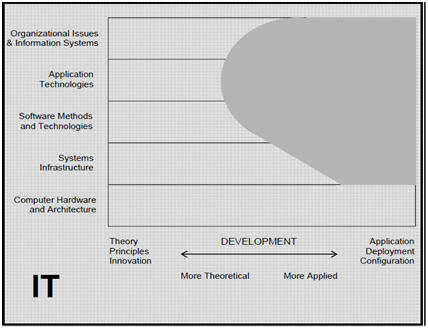|
Untitled 2
Information Technology (IT):
Definition and History of IT:
Information technology is a label that has two meanings. In the broadest sense, the term information technology is often used to refer to all of computing. In academia, it refers to undergraduate degree programs that prepare students to meet the computer technology needs of business, government, healthcare, schools, and other kinds of organizations. Information Technology emphasis is on the technology itself more than on the information it conveys. IT is a new and rapidly growing field that started as a response to the practical, everyday needs of business and other organizations. Information technology programs began to emerge in the late 1990s. During the 1990s, computers became essential work tools at every level of most organizations, and networked computer systems became the information backbone of organizations.
By the end of the 1990s, it became clear that academic degree programs were not producing graduates who had the right mix of knowledge and skills to meet these essential needs. College and universities developed degree programs in information technology to fill this crucial gap.
IT departments within corporations and other organizations took on the new job of ensuring that the organization’s computing infrastructure was suitable, that it worked reliably, and that people in the organization had their computing-related needs met, problems solved, etc.
Today, organizations of every kind are dependent on information technology. They need to have appropriate systems in place. These systems must work properly, be secure, and upgraded, maintained, and replaced as appropriate. Employees throughout an organization require support from IT staff who understand computer systems and their software and are committed to solving whatever computer-related problems they might have.
The Scope of the IT:
The shaded portion in the following figure represents the information technology discipline. Their role has some overlap with IS, but IT people have a special focus on satisfying human needs that arise from computing technology.

The intersection of IT and IS programs:
IS programs now face fresh competition from IT programs. Traditionally, many graduates of IS programs have functioned in roles that are similar to the roles for which IT programs explicitly prepare their students. As the number of IT programs grows, many IS departments will have to evaluate how to define and serve their core constituents. And regardless of the local IS reaction to the emergence of IT programs, there are many potentially rich opportunities for cooperation between the IS and IT communities.
What do IT programs prepare students for?
The new information technology (IT) programs explicitly aim to educate students the work of Planning and Managing Organizational Technology Infrastructure. IT programs focus on producing graduates who know how to make information technology work in a wide range of settings. Organizations of all kinds have become dependent on networked computing infrastructure to such a degree that they cannot function without that infrastructure. IT people are prepared to select, manage, and maintain that infrastructure, ensuring that it meets organizational needs. They also create digital content for that infrastructure and take care of the IT support needs of the individuals who use it.
IT programs exist to produce graduates who possess the right combination of knowledge and practical, hands-on expertise to take care of both an organization’s information technology infrastructure and the people who use it.
What are the responsibilities of the information technology specialists?
Information technology professionals should be able to work effectively at planning, implementation, configuration, and maintenance of an organization’s computing infrastructure. The IT specialists assume responsibility for selecting hardware and software products appropriate for an organization, integrating those products with organizational needs and infrastructure, and installing, customizing, and maintaining those applications for the organization’s computer users. Examples of these responsibilities include the installation of networks; network administration and security; the design of web pages; the development of multimedia resources; the installation of communication components; the oversight of email systems; and the planning and management of the technology lifecycle by which an organization’s technology is maintained, upgraded, and replaced.
Site Map
|